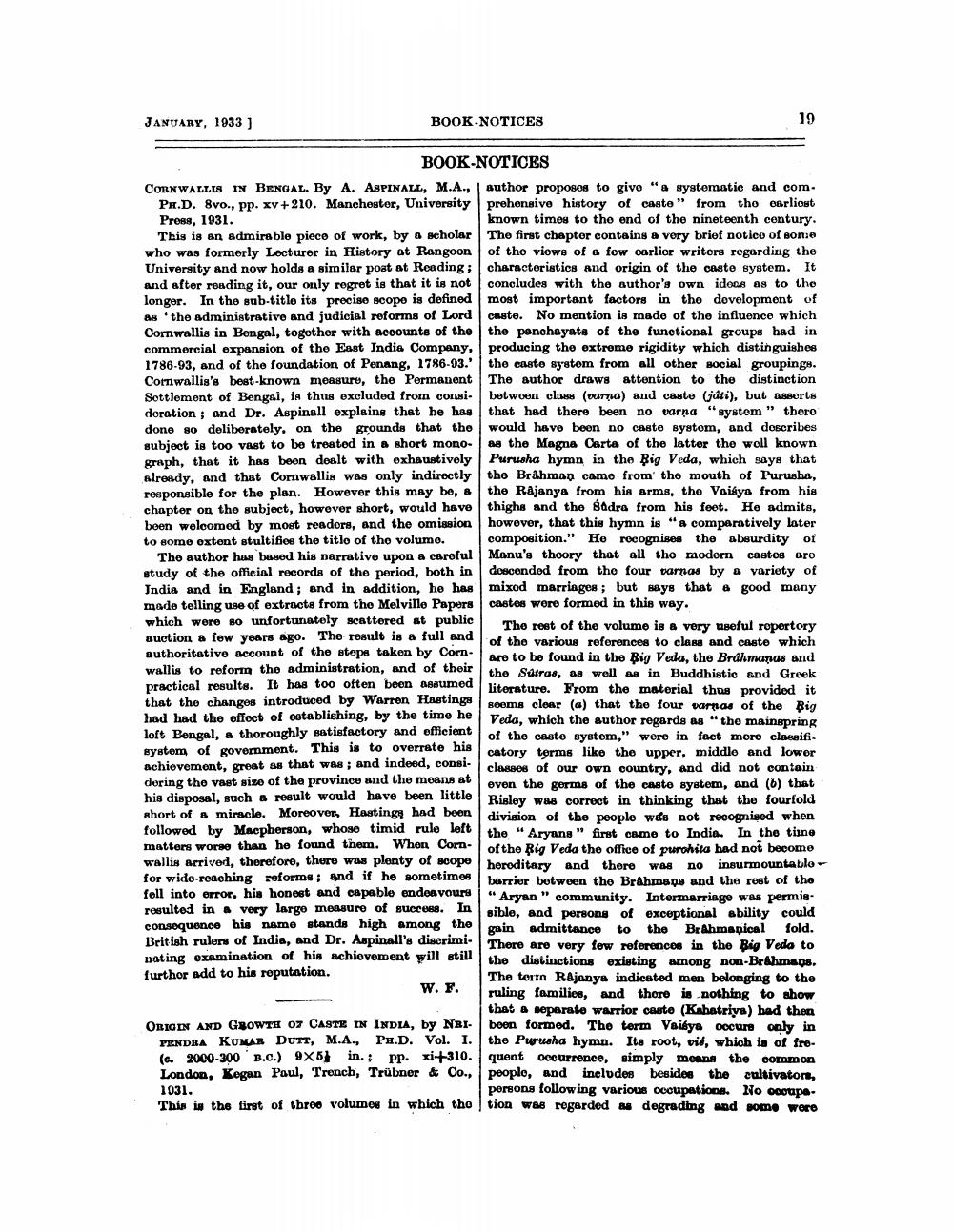________________
JANUARY, 1933)
BOOK NOTICES
19
BOOK-NOTICES CORNWALLIS IN BENGAL. By A. ASPINALL, M.A., author proposes to givo "a systematic and com.
PA.D. 8vo., pp. xv +210. Manchester, University prehensive history of caste" from tho earliost Press, 1931.
known times to tho end of the nineteenth century. This is an admirable piece of work, by a scholar The first chapter contains a very brief notice of bone who was formerly Lecturer in Fistory at Rangoon of the views of a fow oarlier writers regarding the University and now holds a similar post at Reading; characteristics and origin of the caste system. It and after reading it, our only rogret is that it is not concludes with the author's own idocs as to the longer. In the sub-title its precise scope is defined most important factors in tho dovelopment of as 'the administrative and judicial reforms of Lord caste. No mention is made of the influence which Cornwallis in Bengal, together with accounts of the the panchayate of the functional groups had in commercial expansion of the East India Company, producing the extreme rigidity which distinguishes 1786-93, and of the foundation of Penang, 1786-93.1 the caste system from all other social groupings. Comwallis's best-known measure, the Permanent The author draws attention to the distinction Sottlement of Bengal, in thus excluded from consi. betwoen close (varna) and caste (dli), but asserts doration; and Dr. Aspinall explains that he has that had thero been no varna "systom" thoro done so deliberately, on the grounds that the would have been no caste systom, and doscribes subject is too vast to be treated in a short mono- as the Magna Carta of the latter the woll known graph, that it has beon dealt with exhaustively Purusha hymn in the Big Veda, which says that already, and that Cornwallis was only indirectly tho Brahman came from tho mouth of Purusha, responsible for the plan. However this may be, the Rajanya from his arms, tho Voisya from his chapter on the subject, however short, would have thighs and the Bodra from his feet. He admits, been welcomed by most readors, and the omission however, that this hymn is a comparatively later to some oxtont stultifies the titlo of tho volumo. composition." He recognises the absurdity of
Tho author has based his narrativo upon a caroful Monu's thoory that all the modern castes oro study of the official records of the period, both indosconded from the four tarnas by varioty of India and in England; and in addition, he has mixed marriages ; but ways that a good many made telling use of extracts from the Melville Papers castes were formed in this way. which were 80 unfortunately scattered at public
The rest of the volume is a very useful ropertory auction a few years ago. The result is a full and
of the various references to class and caste which authoritative account of the stops taken by Corn.
Are to be found in the Big Veda, the Brahmanas and wallis to reform the administration, and of their
the Súiras, as well as in Buddhistic and Greek practical results. It has too often been assumed
literature. From the material thus provided it that the changes introduced by Warren Hastings
seems clear (a) that the four varnas of the Big had had the effect of establishing, by the time he
Veda, which the author regards as "the mainspring loft Bengal, a thoroughly satisfactory and efficient
of the casto system," were in fact mere classifi. system of government. This is to overrate his
catory terms like the upper, middle and lower achievement, great as that was ; and indeed, consi
classes of our own country, and did not contain dering the vast size of the province and the moans at
even the germs of the caste system, and (b) that his disposal, such a result would have been little
Risley was correct in thinking that the fourfold short of a miracle. Moreover, Hastingy had been
division of the peoplo w¬ recognised when followed by Macpherson, whose timid rule loft
the “Aryans " first came to India. In the tiine matters worse than he found them. Whon Corn
of the Big Veda the office of purohita had not become wallis arrived, therefore, there was plenty of scope
heroditary and there was no insurmountablo for wido-reaching reforms and if he sometimes barrier botwoen tho Brahmaps and the root of the fell into orror, his honest and capable endeavours "Aryan " community. Intermarriage was permis resulted in very large measure of success. Insible, and persons of exceptional ability could consequence his name stands high among the
guin admittance to the Br Ahmapical fold. British rulers of India, and Dr. Aspinall's diserimi.
There are very few references in the Big Veda to nating examination of his achiovement will still
the distinctions existing among non-Brahmaps. furthor add to his reputation.
The torta Rajanya indicated men belonging to the W.F.
ruling families, and thore is nothing to show
that a separate Warrior caste (Kshatriya) had then ORIGIN AND GROWTH OZ CASTE IN INDIA, by NBI- boen formed. The term Vai ya Docure only in
PENDRA KUMAR DUT, M.A., PH.D. Vol. I. the Purusha hymn. Its root, vid, which is of fro(c. 2000-300 D.O.) 9X5 in. Pp. xi-310.quent occurrence, simply means the common London, Kegan Paul, Trench, Trübner & Co., people, and includes besides the cultivaton, 1031.
poreons following various occupations. No oooupaThis is the first of thror volumes in which tho tion was regarded as degrading and some were




